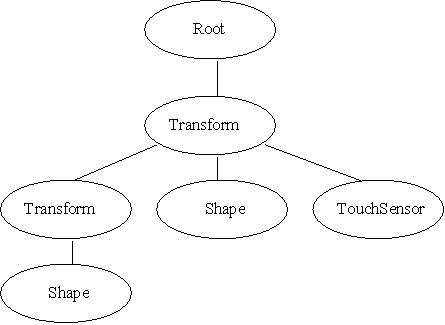VRML 2.0
The Virtual Reality Modeling Language
This section describes key concepts relating to the VRML specification. This describes how to use scene graphs, nodes, events and prototypes.
1.1 Nodes
VRML is simply a file format for describing objects. The objects can be anything: 3D Geometry, music data, images and so on. These objects are called nodes. Nodes are the basic object in a VRML scene. A node has three properties:
- Nam
e
This is the type name. For example: Box, Sphere, TouchSensor ...
- Parameters
The parameters are called fields and they characterize a node. For example, a Sphere node has the radius field to assign its radius, a Light node has the intensity field. VRML defines two kinds of fields:
|
field |
Private property of a node. |
|
ExposedField |
Public property of a node. It can be modified by other nodes. |
- Events
Each node can receive and send events. This allows the nodes to communicate. There are two kinds of events:
|
eventIn |
It denotes an incoming event for a node. An eventIn typically changes a property of the node and its prototype is usually set_events. For example, set_position, set_color, set_intensity.
The declaration is:
eventIn set_foo |
|
EventOut |
It denotes an outgoing event for a node. It indicates that something in the node has changed and so an event has been generated. The prototype is usually events_changed. For example, position_changed, color_changed.
The declaration is:
EventOut foo_changed |
A field declared as exposedField has both the events declaration. For example:
ExposedField foo
Is equivalent to:
field foo
eventIn set_foo
eventOut foo_changed
The set_foo event is generated when another node want to change the foo field. The foo_changed event is generated by the node when the foo property changes.
For example, here is the declaration of TouchSensor:
TouchSensor {
exposedField SFBool enabled TRUE
eventOut SFVec3f hitNormal_changed
eventOut SFVec3f hitPoint_changed
eventOut SFVec2f hitTexCoord_changed
eventOut SFBool isActive
eventOut SFBool isOver
eventOut SFTime touchTime
}
isOver event is generated every time the mouse passes over the sensor.
enabled is the only field of the node. It can receive the event set_enabled and enabled_changed.
1.2 The Structure of the Scene Graph
A VRML scene has an hierarchical structure. The Scene Graph is described by Grouping nodes. Each grouping node has a children field that contains a list of nodes. Each grouping node defines a coordinate space for its children. There are five grouping nodes:
Anchor
Billboard
Collision
Group
Transform
For examples, the declaration of Group is:
Group {
eventIn MFNode addChildren
eventIn MFNode removeChildren
exposedField MFNode children []
field SFVec3f bboxCenter 0 0 0
field SFVec3f bboxSize -1 -1 -1
}
The field children is used to add nodes to the Group. Grouping nodes can be added to the children field to generate an hierarchical structure.
A typical VRML file is:
#VRML V2.0 utf8
Transform {
translation 3 0 1
children [
Transform {
Translation 1 0 0
children [
Shape {
Geometry Sphere { radius 3 }
Appearance Appearance { material
Material { diffuseColor 1 0 0 }
}
]
}
Shape { geometry Box {} }
TouchSensor {}
]
} |

|
1.3 Events
Nodes communicate with themselves sending events. A connection between two nodes is called ROUTE. A ROUTE is a connection between an eventOut and an eventIn of nodes. The syntax is:
ROUTE NodeName.eventOutName TO NomeName.eventInName
NodeName is the name of a node. DEF is used to set the name of a node.
An example :
Transform {
children [
Shape { Sphere {} }
DEF Clicker TouchSensor { }
]
}
Transform {
children [
DEF Light PointLight {}
]
}
ROUTE Clicker.isActive TO Light.on
When the sphere is clicked the light turns on.
1.4 Prototypes
It allows the encapsulation and parameterization of VRML objects.
The syntax is:
PROTO prototypename [ eventIn eventtypename name
eventOut eventtypename name
exposedField fieldtypename name defaultValue
field fieldtypename name defaultValue ... ] {
Geometry description
}
In the interface of the prototype there is the list of eventOuts, eventIns, exposedFields and fields of the node. Only these properties can be access from other nodes.
In the implementation there is the description of the VRML object. The IS statement can be used to associate a field in the interface with a field in the implementation.
This definition only defines a new type that can be used later as if it were a built-in node. An instantiation is used to create a node of this type.
For example:
PROTO fooSphere [ field SFFloat fooRadius 3.0 ] { #Prototype definition
Sphere {
radius 3
radius IS fooRadius
}
}
fooSphere { fooRadius 42.0 } #Instantiation
1.5 References
VRML 2.0 Specifications: official specifications
http://www.vrml.org/Specifications/VRML2.0/
VRML 2.0 Concepts: general concepts about VRML 2.0
http://www.vrml.org/Specifications/VRML2.0/FINAL/spec/part1/concepts.html
VRML 2.0 Nodes Reference: detailed description of all built-in nodes
http://www.vrml.org/Specifications/VRML2.0/FINAL/spec/part1/nodesRef.html
